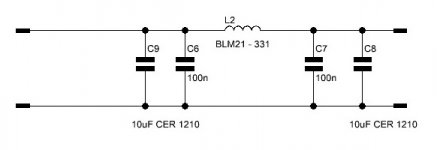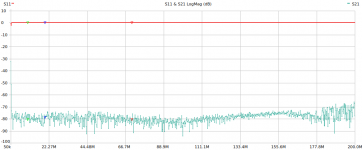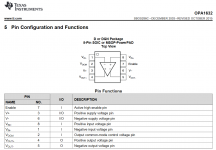In a general sense to me hysteresis distortion is a subtype of noise modulation:
This Thing We Have About Hysteresis Distortion - PURIFI.
For some purposes it may properly viewed as a reduction of DNR. Nonetheless, according to Bruno there can be objectionable audible artifacts associated with it.
So, this "modulation" from a low value power-line ferrite, which may not even be measurable at the supply pins after the decoupling caps, is supposed to make it into the audio band at a magnitude that is audible? All from the supply pins of an op-amp with tremendous amounts of loop gain at these frequencies?
It would be best if you measured and presented something instead of conjuring up implausible, evidence-free explanations for your dogma.
Sorry, you are putting words in Bruno's mouth and twisting the purpose of this Purifi paper to suit your half-baked theory.
I'll have no problem if you can provide any evidence that a simple appropriately chosen ferrite bead in series with the supply pins of an OPA1612 can show "noise modulation" on the analog output with a representative input signal.
Last edited:
I have seen low power ferrites disturb clock power rails to audible effect at the analog output. I have seen them directly affect the sound of line level analog audio, with the sound perceptually just as Bruno described. I wrote about that long before Bruno wrote his 'paper,' which by the way still does not show more than anecdotal evidence for audibility (don't see him getting flak for that). OTOH, I have seen low power ferrites clean up digital power rails to beneficial audible effect. So, I think it can go either way. That's why I suggested listening with and with the ferrites. If no audible difference, then maybe the ferrites are extraneous.
One thing I noticed while looking at ferrites for the digital part was that the lowest resistance ones still had more resistance than the output impedance of the regulators. I'm not sure how much that matters.
I have seen low power ferrites disturb clock power rails to audible effect at the analog output. I have seen them directly affect the sound of line level analog audio, with the sound perceptually just as Bruno described. I wrote about that long before Bruno wrote his 'paper,' which by the way still does not show more than anecdotal evidence for audibility (don't see him getting flak for that). OTOH, I have seen low power ferrites clean up digital power rails to beneficial audible effect. So, I think it can go either way. That's why I suggested listening with and with the ferrites. If no audible difference, then maybe the ferrites are extraneous.
And WTF has "low power ferrites disturb clock power rails" and "low power ferrites clean up digital power rails" with ferrites on the supply pins of an op amp with huge PSRR?
And if your suggestion doesn't help, is the money and time wasting poor victim deaf, is his equipment not good enough to reveal fine details, or the ferrites, surprise, do exactly nothing?
No, after making you happy for a couple of days, I changed to a Kawai piano, to make another snake oil merchant around happy. You can’t expect to have exclusivity, wait your turn.
a simple symmetric filter for power supplys. whether to use it or not is up to you 🙂 I have been using such filters for a long time, if you need an example, here
USB ADC on Cirrus Logic CS5381
USB ADC on Cirrus Logic CS5381
Attachments
New idea.
DACs: AK4490(3), CS4398, ES9038Q2M and etc diff output DACs.
I received my "OPA1632" modules but I can't seem to measure the 30k resistors between the Vocm and V+ or V- pins. So I think these are fake OPA1632.
Could you please do me a favor and quickly measure and post the resistance between pins 2 and 3 and then 2 and 6 on your real OPA1632? (Between the Vocm and the power pins.)
I believe that the 30kOhm resistors should be measurable.
Attachments
I received my "OPA1632" modules but I can't seem to measure the 30k resistors between the Vocm and V+ or V- pins. So I think these are fake OPA1632.
Could you please do me a favor and quickly measure and post the resistance between pins 2 and 3 and then 2 and 6 on your real OPA1632? (Between the Vocm and the power pins.)
I believe that the 30kOhm resistors should be measurable.
They measure about 30.7kOhms.
/Martti
Ok. Thank you. My OPA1632 modules are fake. Sigh.
I wonder what chip it is that they labeled as OPA1632. They have the bevel on one side like Ti parts but the marking does not match the laser marking I see on photos of OPA1632 such as at Electronic Components Distributor | JLCPCB & EasyEDA Parts Online store - LCSC.COM.
I wonder what chip it is that they labeled as OPA1632. They have the bevel on one side like Ti parts but the marking does not match the laser marking I see on photos of OPA1632 such as at Electronic Components Distributor | JLCPCB & EasyEDA Parts Online store - LCSC.COM.
- Home
- Source & Line
- Digital Line Level
- CS4398 output filter





